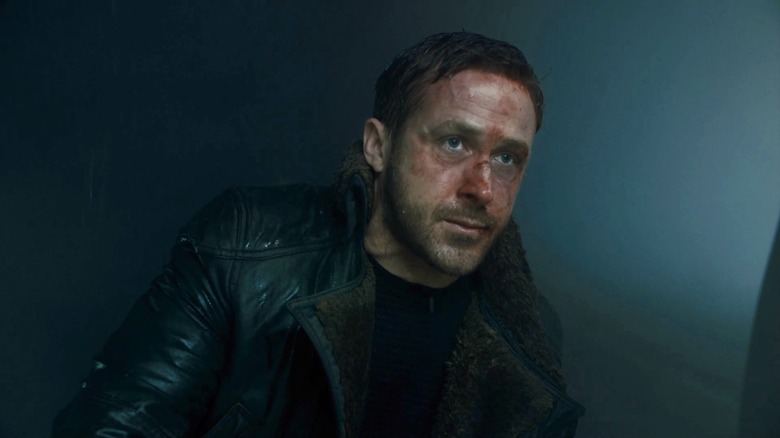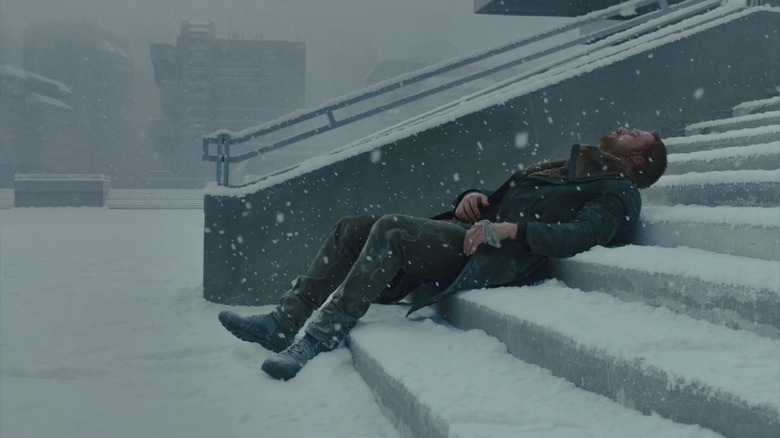Shooting Blade Runner 2049's Climactic Scene Was Two Weeks Of Misery
This post contains spoilers for "Blade Runner 2049."
The ending of "Blade Runner 2049" puts its protagonist, K, played by Ryan Gosling, through the wringer both mentally and physically. No sooner does K have his bubble burst about being the Chosen One — the first human child ever born of a bioengineered replicant — than he is facing down fellow replicant Luv (Sylvia Hoeks) in a brutal fight to the death on a seawall. There, K has intercepted the off-world transport carrying Luv and Rick Deckard (Harrison Ford), who remains handcuffed inside while waves crash all around them and the water level rises, threatening to drown Deckard. Luv wields a knife, blood is spilled, and the struggle to survive extended to the filmmakers, too, apparently.
The seawall scene in Denis Villeneuve's movie — the 2017 sequel to Ridley Scott's original 1982 "Blade Runner" film — was shot on a set in a water tank in Budapest. And according to Paul Lambert, the resident VFX supervisor for Double Negative, it involved "two weeks of night shooting with simulated rain and wind." Lambert and other members of the "Blade Runner 2049" visual effects team spoke to Creative Bloq about the making of the movie, and as Rocky once said, it wasn't "all sunshine and rainbows." Far from it, in fact.
Referring to the flying transport "limo," Lambert said:
"It was absolutely miserable. The limo was on a contraption that allowed it to be pulled into the water. The practical water worked well but there were times that Denis wanted bigger waves, so we augmented with some full CG splashes on the limo. Not having moonlight or a completely lit set was key to the look of this. You could see a few waves out but then it was pitch black."
Tears in the snow
Lambert further recalled how cinematographer Roger Deakins (who, like the visual effects team, won an Oscar for "Blade Runner 2049") employed lighting tricks while filming the limo and the surrounding seawall with K's own parked Spinner. He said:
"One of [the tricks] was to quickly run lights on a cable that gave us interactive light on the inside of the limo as well as on the rain around the limo. We augmented that with the shape of K's Spinner as well as with additional light."
While the rain posed a technical challenge, an even bigger creative challenge for Lambert and company was the realization of K's digital girlfriend, Joi (Ana de Armas), an effect that was "sophisticated and hard to pull off."
Double Negative was one of the studios operating under VFX supervisor John Nelson, who oversaw almost 1,200 shots involving visual effects for "Blade Runner 2049." Nelson recalled how these came into play even in the film's quiet final scene, in which K lays dying on the steps of a building where he has reunited Deckard with the real Chosen One, his daughter. He said:
"There are a lot of invisible effects like the layout of the snow at the end scene when K dies. All of that background didn't exist. [...] We had the steps and part of the building but no glass on the front of the building. We shot it with practical snow and added more digitally. That whole city back there was recreated."
For the artists responsible for bringing it to life, "Blade Runner 2049" may have sometimes been a tough shoot, filled with blood, sweat, and tears — in the snow, if not the rain. However, it was undoubtedly a labor of love, and it certainly resulted in one of the best films of the 2010s.

